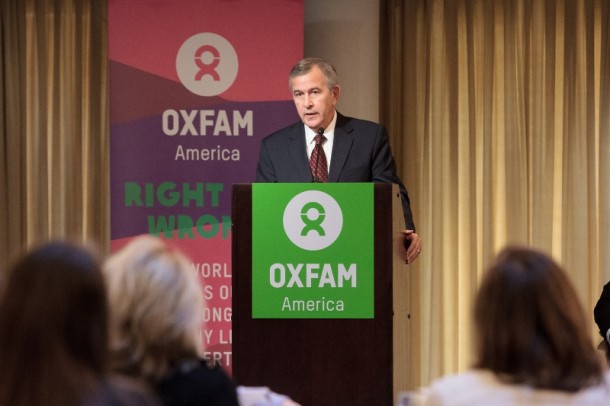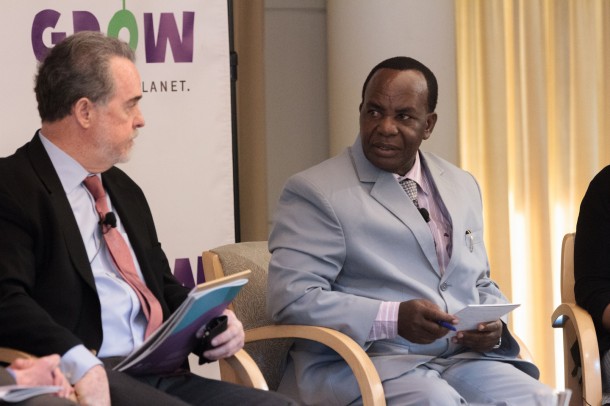Is Feed the Future leading to lasting improvements to global food security?
 "We've learned to select quality seed, to grow quality rice. How to use the right fertilizer, how much and when. How to track our expenses, how much you need to sell to make a profit. How to get credit and use it the right way, so you can make proper financial plans and avoid bad debt." Ndeye Gaye is a farmer in Senegal, a Feed the Future focus country. Photo: Rebecca Blackwell / Oxfam America
"We've learned to select quality seed, to grow quality rice. How to use the right fertilizer, how much and when. How to track our expenses, how much you need to sell to make a profit. How to get credit and use it the right way, so you can make proper financial plans and avoid bad debt." Ndeye Gaye is a farmer in Senegal, a Feed the Future focus country. Photo: Rebecca Blackwell / Oxfam America
Oxfam’s new report offers insights on Feed the Future’s promise and potential.
Emmanuel Tumusiime is a researcher on economic justice and agriculture at Oxfam America.
Since the food price crisis of 2008, the US has refocused its attention on agriculture to improve food security. In 2010 it launched Feed the Future, an initiative meant to harness the capacity, resources, and commitment of agencies across the US government.

For nearly as long, Oxfam has been studying how Feed the Future (FtF) works, seeking to understand whether the initiative will make inclusive and lasting contributions to the fight against hunger.
Yesterday marked the culmination of our efforts, with the release of Oxfam America’s new report, Promise and Potential: Delivering inclusive, sustainable development for small-scale food producers through the Feed the Future initiative. The report synthesizes key findings from six country case studies: Ethiopia, Ghana (report forthcoming), Guatemala, Haiti, Senegal and Tanzania. Our framework of analysis emphasized four key themes: inclusiveness, empowerment, aid effectiveness, and sustainability – key areas central to ending hunger and extreme poverty.

As the report concludes, FtF should be applauded for bringing agriculture back to the center of the US development agenda. There is no doubt FtF has demonstrated substantial, real, and important improvements in the way the US government, especially the US Agency for International Development (USAID), delivers assistance.
For instance, we found that FtF is implemented in a way that supports national agricultural development strategies and plans, helping to ensure greater country ownership of US investments. The initiative has also committed to reaching and empowering women farmers.
At the same time, we find that continued efforts are needed to refine and strengthen FtF. Our report found:
-
More work remains to be done to ensure inclusive participation of farmers in FtF project activities, specifically those related to agricultural productivity.
It is important to avoid an overreliance on market-led investment approaches as uniformly appropriate for addressing rural poverty and food insecurity. Investments for agricultural production should take better account of significant variations in agricultural resources and potential between and within farming communities. This requires a variety of strategies that US assistance should embrace.
-
A more concerted focus on capacity building, especially to support farmers in claiming their rights, would help improve the sustainability of the initiative.
Emphasis on building skills and knowledge of farmers with sustainable farming practices is remarkable in FtF implementation. Yet investment is also needed in capacity building initiatives that raise awareness about the rights citizens hold and corresponding government responsibilities.
-
Strong support at the national level for consultation, collaboration and alignment – keysfor delivering effective aid – must be carried to the community level as well.
While Feed the Future is putting into practice key principles to ensure responsive and effective aid, Oxfam’s research found limited engagement in design and implementation of interventions by local stakeholders, particularly those at the sub-national level.
-
The approach to natural resource management is welcome, but could be strengthened through more attention to promoting low-external-input techniques for sustainable agriculture.
In prioritizing environmental sustainability, Feed the Future investments emphasize efficient use of resources, including agrochemical inputs, delivered through private sector channels. This approach misses the opportunity to teach farmers important alternatives, including agro-ecological approaches that emphasize farmer knowledge and mimic natural processes that focus not just on economic sustainability but also ecological and social sustainability.
Taken together, Oxfam’s findings and the recommendations for Feed the Future that accompany them suggest the need for some fine-tuning (not overhauling) of the initiative in order to ensure it will achieve lasting impact.